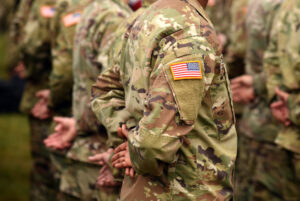What the Laws of War Allow
Was the massacre of 13 Iraqis publicized in the WikiLeaks video "Collateral Murder" really a “war crime” -- or just plain old war? Some have argued that the slaughter, if legal, was therefore justified and, though unfortunate, no big deal. But it is possible to draw a starkly different conclusion: the “legality” of this act is an indictment of the laws of war as we know them.
By Chase Madar, TomDispatchThis piece originally appeared at TomDispatch.
Anyone who would like to witness a vivid example of modern warfare that adheres to the laws of war — that corpus of regulations developed painstakingly over centuries by jurists, humanitarians, and soldiers, a body of rules that is now an essential, institutionalized part of the U.S. armed forces and indeed all modern militaries — should simply click here and watch the video.
Wait a minute: that’s the WikiLeaks “Collateral Murder” video! The gunsight view of an Apache helicopter opening fire from half a mile high on a crowd of Iraqis — a few armed men, but mostly unarmed civilians, including a couple of Reuters employees — as they unsuspectingly walked the streets of a Baghdad suburb one July day in 2007.
Watch, if you can bear it, as the helicopter crew blows people away, killing at least a dozen of them, and taking good care to wipe out the wounded as they try to crawl to safety. (You can also hear the helicopter crew making wisecracks throughout.) When a van comes on the scene to tend to the survivors, the Apache gunship opens fire on it too, killing a few more and wounding two small children.
The slaughter captured in this short film, the most virally sensational of WikiLeaks’ disclosures, was widely condemned as an atrocity worldwide, and many pundits quickly labeled it a “war crime” for good measure.
But was this massacre really a “war crime” — or just plain-old regular war? The question is anything but a word-game. It is, in fact, far from clear that this act, though plainly atrocious and horrific, was a violation of the laws of war. Some have argued that the slaughter, if legal, was therefore justified and, though certainly unfortunate, no big deal. But it is possible to draw a starkly different conclusion: that the “legality” of this act is an indictment of the laws of war as we know them.
The reaction of professional humanitarians to the gun-sight video was muted, to say the least. The big three human rights organizations — Human Rights Watch (HRW), Amnesty International, and Human Rights First — responded not with position papers and furious press releases but with silence. HRW omitted any mention of it in its report on human rights and war crimes in Iraq, published nearly a year after the video’s release. Amnesty also kept mum. Gabor Rona, legal director of Human Rights First, told me there wasn’t enough evidence to ascertain whether the laws of war had been violated, and that his organization had no Freedom of Information Act requests underway to uncover new evidence on the matter.
This collective non-response, it should be stressed, is not because these humanitarian groups, which do much valuable work, are cowardly or “sell-outs.” The reason is: all three human rights groups, like human rights doctrine itself, are primarily concerned with questions of legality. And quite simply, as atrocious as the event was, there was no clear violation of the laws of war to provide a toehold for the professional humanitarians.
The human rights industry is hardly alone in finding the event disturbing but in conformance with the laws of war. As Professor Gary Solis, a leading expert and author of a standard text on those laws, told Scott Horton of Harper’s Magazine, “I believe it unlikely that a neutral and detached investigator would conclude that the helicopter personnel violated the laws of armed conflict. Legal guilt does not always accompany innocent death.” It bears noting that Gary Solis is no neocon ultra. A scholar who has taught at the London School of Economics and Georgetown, he is the author of a standard textbook on the subject, and was an unflinching critic of the Bush-Cheney administration.
War and International “Humanitarian” Law
“International humanitarian law,” or IHL, is the trying-too-hard euphemism for the laws of war. And as it happens, IHL turns out to be less concerned with restraining military violence than licensing it. As applied to America’s recent wars, this body of law turns out to be wonderfully accommodating when it comes to the prerogatives of an occupying army.Here’s another recent example of a wartime atrocity that is perfectly legal and not a war crime at all. Thanks to WikiLeaks’ Iraq War Logs, we now know about the commonplace torture practices employed by Iraqi jailers and interrogators during our invasion and occupation of that country. We have clear U.S. military documentation of sexual torture, of amputated fingers and limbs, of beatings so severe they regularly resulted in death.
Surely standing by and taking careful notes while the Iraqi people you have supposedly liberated from tyranny are getting tortured, sometimes to death, is a violation of the laws of war. After all, in 2005 General Peter Pace, then Chairman of the Joint Chiefs of Staff, publicly contradicted his boss Secretary of Defense Donald Rumsfeld by commenting into a live mike that it is “absolutely the responsibility of every American soldier to stop torture whenever and wherever they see it.” (A young private working in Army Intelligence named Bradley Manning, learning that a group of Iraqi civilians handing out pamphlets alleging government corruption had been detained by the Iraqi federal police, raised his concern with his commanding officer about their possible torture. He was reportedly told him to shut up and get back to work helping the authorities find more detainees.)
As it turned out, General Pace’s exhortation was at odds with both official policy and law: Fragmentary Order 242, issued by Donald Rumsfeld’s Pentagon, made it official policy for occupying U.S. troops not to interfere with ongoing Iraqi torture. And this, according to some experts, is no violation of the laws of war either. Prolix on the limits imposed on the acts of non-state fighters who are not part of modern armies, the Geneva Conventions are remarkably reticent on the duties of occupying armies.
As Gary Solis pointed out to me, Common Article 1 of the Fourth Geneva Convention assigns only a vague obligation to “ensure respect” for prisoners handed over to a third party. On the ground in either Iraq or Afghanistan, this string of words would prove a less-than-meaningful constraint.
Part of the problem is that the laws of war that aspire to restrain deadly force are often weakly enforced and routinely violated. Ethan McCord, the American soldier who saved the two wounded children from that van in the helicopter video, remembers one set of instructions he received from his battalion commander: “Anytime your convoy gets hit by an IED, I want 360 degree rotational fire. You kill every [expletive] in the street!” (“That order,” David Glazier, a jurist at the National Institute for Military Justice, told me, “is absolutely a war crime.”) In other words, the rules of engagement that are supposed to constrain occupying troops in places like Afghanistan and Iraq are, according to many scholars and investigators, often belittled and ignored.
Legalized Atrocity
The real problem with the laws of war, however, is not what they fail to restrain but what they authorize. The primary function of International Humanitarian Law is to legalize remarkable levels of “good” military violence that regularly kill and injure non-combatants. IHL highlights a handful of key principles: the distinction between combatant and civilian, the obligation to use force only for military necessity, and the duty to jeopardize civilians only in proportion to the military value of a target.
Even when these principles are applied conscientiously — and often they aren’t — they still allow for remarkable levels of civilian carnage, which the Pentagon has long primly (and conveniently) referred to as “collateral damage,” as if it were a sad sideline in the prosecution of war. And yet civilian deaths in modern war regularly are the central aspect of those wars, both statistically and in other ways. Far from being universally proscribed, the killing of high numbers of civilians in a battle zone is often considered absolutely legal under those laws. In the pungent phrase of Professor David Kennedy of Harvard Law School, “We should be clear — this bold new vocabulary beats ploughshares into swords as often as the reverse.”
The relative weakness of the laws of war when it comes to preventing atrocities is not simply some recent debasement perpetrated by neoconservative Visigoths. Privileging the combatant and his (it’s usually “his”) prerogatives has been the historical bone marrow of those laws. In the Vietnam War, for instance, the declaration of significant parts of the South Vietnamese countryside as “free-fire zones,” and the “carpet bombing” of rural areas by B-52s carrying massive payloads were also done under cover of the laws of war.IHL has certainly changed in some respects. A century ago, the discourse around the laws of war was far more candid than today. Jurists once regularly referred to “non-uniformed unprivileged combatants” simply as “savages” and the consensus view in mainstream scholarly journals of international law was that a modern army could do whatever it wanted to such obstreperous, lawless people (especially, of course, in what was still then the colonial world). On the whole, the history of IHL is a long record of codifying the privileges of the powerful against lesser threats like civilians and colonial subjects resisting invasion.
Even though the laws of war have usually been one more weapon of the strong against the weak, a great deal of their particular brand of legalism has seeped into antiwar discourse. One of the key talking points for many arguing against the invasion of Iraq was that it was illegal — and that was certainly true. But was the failure to procure a permission slip from the United Nations really the main problem with this calamitous act of violence? Would U.N. authorization really have redeemed any of it? There is also a growing faith that war can be domesticated under a relatively new rubric, “humanitarian intervention,” which purports to apply military violence in precise and therapeutic dosages, all strictly governed by international humanitarian law.
Here is where the WikiLeaks disclosures were so revealing. They remind us, once again, that the humanitarian dream of “clean warfare” — military violence that is smoothly regulated by laws that spare civilians — is usually a sick joke. We need to wean ourselves from the false comfort that the law is always on the side of civilians. We need to scrap our tendency to assume that international law is inherently virtuous, and that anything that shocks our conscience — that helicopter video or widespread torture in Iraq under the noses of U.S. soldiers — must be a violation of this system, rather than its logical and predictable consequence.
Let’s be clear: what killed the civilians walking the streets of Baghdad that day in 2007 was not “war crimes,” but war. And that holds for so many thousands of other Afghan and Iraqi civilians killed by drone strikes, air strikes, night raids, convoys, and nervous checkpoint guards as well.
Regulatory Capture
Who, after all, writes the laws of war? Just as the regulations that govern the pharmaceutical and airline industries are often gamed by large corporations with their phalanxes of lobbyists, the laws of war are also vulnerable to “regulatory capture” by the great powers under their supposed rule. Keep in mind, for instance, that the Pentagon employs 10,000 lawyers and that its junior partner in foreign policy making, the State Department, has a few hundred more. Should we be surprised if in-house lawyers can sort out “legal” ways not to let those laws of war get in the way of the global ambitions of a superpower?
It’s only fair that the last words on the laws of war go to Private Bradley Manning, now sitting in a prison cell in Ft. Leavenworth, Kansas, awaiting court-martial for allegedly passing troves of classified material to WikiLeaks, documents that offer the unvarnished truth about the Afghan War, the Iraq War, and Guantánamo. They are taken from the instant-message chatlogs he wrote under the handle of “bradass87” to the informant who turned him in. The young private saw very clearly what so many professors and generals take pains to deny: that the primary function of the laws of war is not to restrain violence, but to justify it, often with the greatest lawyerly ingenuity.
(02:27:47 PM) bradass87: i mean, we’re better in some respects… we’re much more subtle… use a lot more words and legal techniques to legitimize everything…
(02:28:19 PM) bradass87: but just because something is more subtle, doesn’t make it right
Chase Madar, a TomDispatch regular and author of a new book, “The Passion of Bradley Manning” (OR Books), is a lawyer in New York. To listen to Timothy MacBain’s latest two-part Tomcast audio interview in which Madar discusses the Manning case and his new book, click here for part 1 and here for part 2, or download it to your iPod here. Madar tweets @ChMadar https://twitter.com/#!/chmadar.
Follow TomDispatch on Twitter @TomDispatch and join us on Facebook.
Copyright 2012 Chase Madar
Your support matters…Independent journalism is under threat and overshadowed by heavily funded mainstream media.
You can help level the playing field. Become a member.
Your tax-deductible contribution keeps us digging beneath the headlines to give you thought-provoking, investigative reporting and analysis that unearths what's really happening- without compromise.
Give today to support our courageous, independent journalists.






You need to be a supporter to comment.
There are currently no responses to this article.
Be the first to respond.